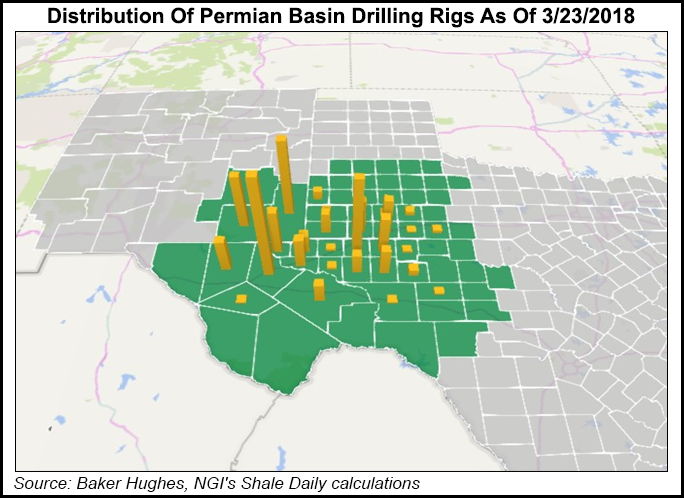E&P | NGI All News Access | NGI The Weekly Gas Market Report | Permian Basin
Permian’s Shifting, Sinking Ground ‘Not Normal,’ Say SMU Researchers
A large swath of the Permian Basin in West Texas is “heaving and sinking,” likely the result of decades of oil and gas production, according to a geophysical team from Southern Methodist University (SMU) in Dallas.

Two sinkholes near Wink could be the beginning of many more in the lightly populated, ancient basin, researchers have determined. Based on radar satellite images, portions of four Texas counties — Pecos, Reeves, Ward and Winkler — also appear to be sinking and uplifting across a 4,000 square-mile area. The findings were published in the Nature’s Scientific Reports.
“The ground movement we’re seeing is not normal,” said SMU geophysicist Zhong Lu, a global expert in satellite radar imagery analysis. “These hazards represent a danger to residents, roads, railroads, levees, dams, and oil and gas pipelines, as well as potential pollution of groundwater.
“Proactive, continuous detailed monitoring from space is critical to secure the safety of people and property.”
The study area included the towns of Pecos, Monahans, Fort Stockton, Imperial, Wink and Kermit. One location indicated as much as 40 inches had moved in the past two-and-a-half years, researchers said.
Medium-resolution (15-65 feet) radar imagery was taken between November 2014 and April 2017, which led to the discovery of the shifting ground. The imagery was then compiled with oil well production data from the Railroad Commission of Texas.
“Our analysis looked at just this 4,000-square-mile area,” said study co-author Jin-Woo Kim, a research scientist in the SMU Department of Earth Sciences. “We’re fairly certain that when we look further, and we are, that we’ll find there’s ground movement even beyond that.
“This region of Texas has been punctured like a pin cushion with oil wells and injection wells since the 1940s, and our findings associate that activity with ground movement.”
Of note is a potential sinkhole in the southeastern corner of New Mexico, where the Permian extends. A nearly decade-old abandoned brine well in Eddy County near Carlsbad may be a potential sinkhole.
The Permian consists of ancient marine rocks underlain by water-soluble rocks and multiple oil- and natural gas-rich formations. Many localized geohazards, such as ground subsidence and micro-earthquakes, may have gone unnoticed, SMU researchers said.
“Based on our observations and analyses, human activities of fluid (saltwater, carbon dioxide) injection for stimulation of hydrocarbon production, salt dissolution in abandoned oil facilities, and hydrocarbon extraction, each have negative impacts on the ground surface and infrastructures, including possible induced seismicity,” they reported.
“Proactive continuous and detailed monitoring of ground deformation from space over the currently operating and the previously operated oil/gas production facilities, as demonstrated by this research, is essential to securing the safety of humanity, preserving property, and sustaining the growth of the hydrocarbon production industry.”
The most significant subsidence was found about one-half-mile east of an existing sinkhole, Wink No. 2, where two subsidence bowls were discovered, “one of which has sunk more than 15.5 inches a year,” researchers said.
The two “Wink Sinks” are located between Wink and Kermit near the tapped out Hendrick oilfield. They gained national attention in 2016 after a study found they were at risk of collapsing into each other as they grew and the land sank.
“The rapid sinking is most likely caused by water leaking through abandoned wells into the Salado formation and dissolving salt layers, threatening possible ground collapse,” said researchers.
Radar also detected upheaval of about 2.1 inches at two wastewater injection wells 9.3 miles west of Wink and Kermit, which coincided with increases in injection volume.
“The injection wells extend about 4,921 feet to 5,577 feet deep into a sandstone formation,” researchers noted.
Near 11 carbon dioxide (CO2) injection wells about seven miles southwest of Monahans, the radar analysis detected surface uplift of more than one inch from wells that are 2,460-2,657 feet deep.
“As with wastewater injection, CO2 injection increased pore pressure in the rocks, so when stress was relieved it was followed by uplift of about one inch at the surface.”
An area 4.3 miles southwest of Imperial also was analyzed where there was reported to be “significant subsidence” from freshwater flowing through cracked well casings, corroded steel pipes and unplugged abandoned wells.
About 5.5 miles south of Pecos, radar analysis detected more than one inch of subsidence near new wells drilled via hydraulic fracturing and in production since early 2015.
“There have also been six small earthquakes recorded there in recent years, suggesting the deformation of the ground generated accumulated stress and caused existing faults to slip,” said the study.
“We have seen a surge of seismic activity around Pecos in the last five to six years,” said Kim. “Before 2012, earthquakes had not been recorded there. At the same time, our results clearly indicate that ground deformation near Pecos is occurring.
“Although earthquakes and surface subsidence could be coincidence, we cannot exclude the possibility that these earthquakes were induced by hydrocarbon production activities.”
More seismic stations and continuous surface monitoring was recommended.
“This is necessary to learn the cause of recent increased seismic activity,” Kim said. “Our efforts to continuously monitor West Texas with this advanced satellite technique can help sustain safe, ongoing oil production.”
According to SMU, the study is considered one of the first of its kind to identify small-scale deformation signals over a vast region by drawing from big data sets spanning several years and then adding supplementary information. The research was supported by the NASA Earth Surface and Interior Program, and the Shuler-Foscue Endowment at SMU.
© 2024 Natural Gas Intelligence. All rights reserved.
ISSN © 2577-9877 | ISSN © 1532-1266 | ISSN © 2158-8023 |
